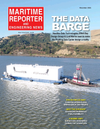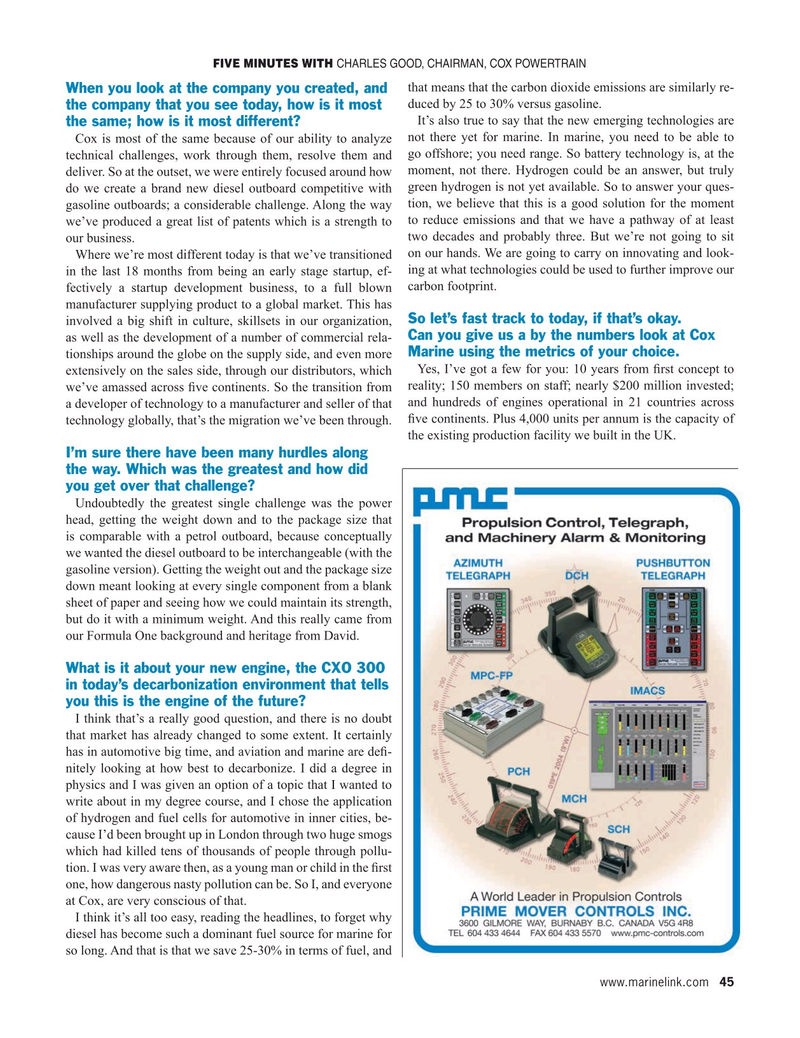
Page 45: of Maritime Reporter Magazine (November 2021)
The Workboat Edition
Read this page in Pdf, Flash or Html5 edition of November 2021 Maritime Reporter Magazine
FIVE MINUTES WITH CHARLES GOOD, CHAIRMAN, COX POWERTRAIN that means that the carbon dioxide emissions are similarly re-
When you look at the company you created, and duced by 25 to 30% versus gasoline. the company that you see today, how is it most
It’s also true to say that the new emerging technologies are the same; how is it most different?
Cox is most of the same because of our ability to analyze not there yet for marine. In marine, you need to be able to technical challenges, work through them, resolve them and go offshore; you need range. So battery technology is, at the deliver. So at the outset, we were entirely focused around how moment, not there. Hydrogen could be an answer, but truly do we create a brand new diesel outboard competitive with green hydrogen is not yet available. So to answer your ques- gasoline outboards; a considerable challenge. Along the way tion, we believe that this is a good solution for the moment we’ve produced a great list of patents which is a strength to to reduce emissions and that we have a pathway of at least two decades and probably three. But we’re not going to sit our business.
Where we’re most different today is that we’ve transitioned on our hands. We are going to carry on innovating and look- ing at what technologies could be used to further improve our in the last 18 months from being an early stage startup, ef- fectively a startup development business, to a full blown carbon footprint.
manufacturer supplying product to a global market. This has
So let’s fast track to today, if that’s okay. involved a big shift in culture, skillsets in our organization,
Can you give us a by the numbers look at Cox as well as the development of a number of commercial rela-
Marine using the metrics of your choice.
tionships around the globe on the supply side, and even more
Yes, I’ve got a few for you: 10 years from ? rst concept to extensively on the sales side, through our distributors, which we’ve amassed across ? ve continents. So the transition from reality; 150 members on staff; nearly $200 million invested; a developer of technology to a manufacturer and seller of that and hundreds of engines operational in 21 countries across ? ve continents. Plus 4,000 units per annum is the capacity of technology globally, that’s the migration we’ve been through.
the existing production facility we built in the UK.
I’m sure there have been many hurdles along the way. Which was the greatest and how did you get over that challenge?
Undoubtedly the greatest single challenge was the power head, getting the weight down and to the package size that is comparable with a petrol outboard, because conceptually we wanted the diesel outboard to be interchangeable (with the gasoline version). Getting the weight out and the package size down meant looking at every single component from a blank sheet of paper and seeing how we could maintain its strength, but do it with a minimum weight. And this really came from our Formula One background and heritage from David.
What is it about your new engine, the CXO 300 in today’s decarbonization environment that tells you this is the engine of the future?
I think that’s a really good question, and there is no doubt that market has already changed to some extent. It certainly has in automotive big time, and aviation and marine are de? - nitely looking at how best to decarbonize. I did a degree in physics and I was given an option of a topic that I wanted to write about in my degree course, and I chose the application of hydrogen and fuel cells for automotive in inner cities, be- cause I’d been brought up in London through two huge smogs which had killed tens of thousands of people through pollu- tion. I was very aware then, as a young man or child in the ? rst one, how dangerous nasty pollution can be. So I, and everyone at Cox, are very conscious of that.
I think it’s all too easy, reading the headlines, to forget why diesel has become such a dominant fuel source for marine for so long. And that is that we save 25-30% in terms of fuel, and www.marinelink.com 45
MR #11 (34-49).indd 45 11/4/2021 11:01:25 AM

 44
44

 46
46
